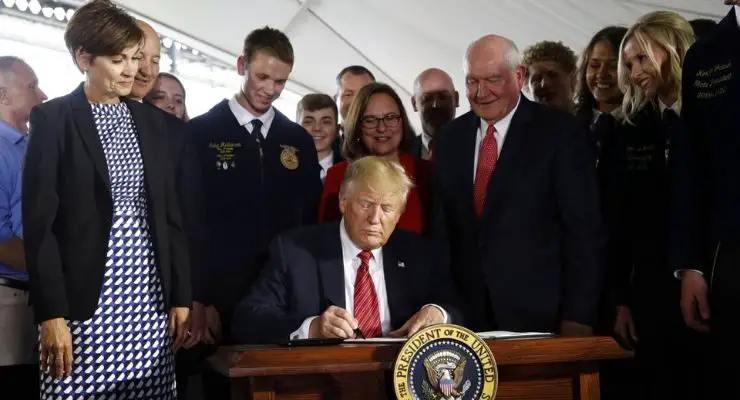Op 11
juni jl. heeft Trump een 'executive order' gelanceerd waarmee de
'strenge regels' t.a.v. gentech voedsel (zowel genetisch gemanipuleerde planten als dieren....) teniet moeten worden
gedaan...... 'Strenge regels' tussen aanhalingstekens, daar die
regels in de VS allesbehalve streng zijn.......
Trump
wil genetische manipulatie van planten en dieren o.a. om de
voedselveiligheid te verbeteren..... ha! ha! ha! ha! ha!
Voor ons
zal e.e.a. betekenen dat we straks met een vrijhandelsverdrag als
TTIP te maken krijgen, waarin de VS gewaarborgd wil hebben dat
gentech producten, hetzij plantaardig dan wel dierlijk, ook in de
schappen van onze supermarkten zullen worden aangeboden..... Waar
geheime rechtbanken (ISDS) zullen zorgen dat de bedrijven die
dergelijke producten aanbieden aan het langste eind trekken en
waarbij wij fiks zullen moeten inleveren op voedselveiligheid......
Voedselveiligheid een woord
dat met een groot aantal producten al geweld wordt aangedaan, neem
met gif platgespoten fruit en groente uit arme landen, waar
Nederlandse telers zich niet hoeven te houden aan 'de strenge regels' zoals die hier gelden, maar wel hun producten uit die landen mogen verkopen op de Nederlandse markt.........
Trump heeft met deze order ook opdracht gegeven aan de 'minister' die over landbouw en veeteelt gaat, de bevolking te onderrichten over GMO voedsel en dat dit 'volkomen veilig is voor consumptie.......'
Overigens opvallend 'weinig aandacht' in de reguliere media voor deze stap van het beest Trump, niet in de laatste plaats daar de plutocraten en investeerders die deze media in handen hebben, 'niet zelden' grote aandelenpakketten hebben in firma's als Bayer-Monsanto.......
Overigens is ook de EU voor een fiks deel tegen het duidelijk etiketteren van GMO voedsel, maar ja, de EU is er dan ook in de eerste plaats voor bedrijven en welgestelden, waar de EU bevolking ergens achteraan hangt.... Ofwel: ook hier gaan de centen ver voor op de volksgezondheid.....
Het volgende artikel werd geschreven door Derrick Broze en gepubliceerd op The Mind Unleashed:
Trump Just Made It a Lot Easier for GMOs to Enter the Food Supply

President Trump issued an executive order aimed at "streamlining" GMO regulations in the US.
DERRICK BROZE
(TMU) —
On June 11, President Donald Trump quietly issued
an executive order to
“streamline” GMO regulations in the United States. The order,
titled Modernizing
the Regulatory Framework for Agricultural Biotechnology Products, is
the latest move by the Trump administration aimed at promoting the
use of genetically engineered or modified crops.
In
his executive order, Trump called on federal agencies to fix what he
called a “regulatory
maze”
related to the farming and selling of GMO products.
The
executive order states:
“Biotechnology can help the Nation meet its food production needs, raise the productivity of the American farmer, improve crop and animal characteristics, increase the nutritional value of crop and animal products, and enhance food safety. In order to realize these potential benefits, however, the United States must employ a science-based regulatory system that evaluates products based on human health and safety and potential benefits and risks to the environment. Such a system must both foster public confidence in biotechnology and avoid undue regulatory burdens.“
The
order goes on to instruct the Secretary of Agriculture and other
officials to “develop
an action plan to facilitate engagement with consumers in order to
build public confidence in, and
acceptance of,
the use of safe biotechnology in agriculture and the food
system” [emphasis
added].
The
executive order also lays out plans for the Trump administration to
work with other nations in developing GMO policies. Section 8 of the
order gives the Ag Secretary and Secretary of State 180 days to
develop an international communications and outreach strategy to
facilitate engagement abroad with policymakers, consumers, industry,
and other stakeholders.
Additionally,
the order calls on the Department of Agriculture, the Environmental
Protection Agency, and the Food and Drug Administration to design a
website that contains and provides links to relevant United States
Government regulatory information.
Greg
Jaffe, biotechnology director at the Center for Science in the Public
Interest, told the Associated
Press that
the impact of the order depends on how the federal government
responds. “There
needs to be an assurance of safety for those products,”
Jaffe said.
The
topic of genetically engineered food has been controversial for
years. Scientists, health advocates, and concerned citizens have been
raising questions about the technology over the last decade,
including activists forming global marches against biotechnology
giant Monsanto between 2013 and 2016.
More
recently, criticism of GMOs has centered around labeling laws. To
understand the current battle for labeling genetically engineered
foods, one must look back to 2015. At that time, the controversial
Safe and Accurate Food Labeling Act passed the House in June before
ultimately failing amid heavy opposition.
To
critics, the bill was known as the “DARK” (Deny Americans the
Right to Know) Act because the law was also aimed at nullifying GMO
labeling measures, such as a state labeling bill passed in Vermont.
Mike Pompeo, author of the bill, criticized mandatory labeling laws
as unnecessarily costly and insisted a federal standard was the
answer.
In
late February 2016, U.S. Senate Agriculture Committee Chairman Pat
Roberts introduced another bill which attempted to create a federal
voluntary standard for labeling GE food. Roberts’ Senate Bill 2609,
or the Biotech Labeling Solutions Act, would have blocked mandatory
labeling efforts by states.
In
March 2016, the bill failed to reach the 60 votes needed during a
procedural vote, with 49 votes in favor and 48 votes against.
However, by July 2016 the labeling measure was added to the National
Sea Grant College Program Act as the National Bioengineered Food
Disclosure Standard.
It was that measure which was ultimately signed into law by Obama,
placing the U.S. Department of Agriculture in charge of labeling
America’s genetically engineered food supply.
Under
the Trump administration, the battle for labeling has died down
largely due to a lack of reporting in the mainstream press and
misinformation which falsely tells Americans that labeling rights
have been won.
However,
in July 2018, an
analysis of proposed rule changes revealed
that thousands of genetically engineered foods may be exempt from
upcoming labeling requirements. In early May 2018, the Department of
Agriculture released a draft rule describing how the labeling law is
supposed to be implemented.
Between
May and July 3, the USDA received 14,008 public comments.
The comments indicate
that some of the public is concerned about the language used in the
rule. “The
term bioengineered should not be used. It is both misleading and
confusing to consumers. GMO, GE or Genetic Engineering should be used
instead,”
one commenter writes. “Please
make all food items labeled correctly as GMO so consumers know
exactly what they are purchasing,”
another said.
The
Environmental Working Group reports that
if companies want to label foods which are made with genetically
engineered ingredients, they must use the terms “bioengineered”
or “bioengineered food ingredient,” instead of the widely known
phrases “genetically modified” or “genetically engineered.”
Interestingly,
the International Food Information Council (IFIC) recently
conducted a
survey to
see how people respond to these different labels, including new
symbols being tested by the USDA. The IFIC found that in every
combination of label, the level of concern among consumers increased.
In the survey consumers were shown bottles of canola oil without any
label, with one of three symbols (plant, sun, or smile), with a
symbol plus “bioengineered” on the label, and a symbol with “may
be bioengineered” on the label.
As
the USDA works to establish a uniform national standard for labeling
foods that may be genetically engineered, critics continue to call
out the dangers of putting the federal government in charge of the
situation. Donald Trump’s recent executive order will only
exacerbate the already
confusing situation.
Americans
who have concerns about the safety of GMOs will have to wrestle with
the fact that these products may not be labeled and—with the latest
executive order from Trump—will enter the food supply at an
increasing pace in the coming years.
===============================
Zie ook:
'Trump geeft groen licht aan gentechvoedsel, nu nog toestemming van de EU.........'
'VS ontwikkelt nieuw biowapen: genetisch gemanipuleerde insecten'
Voor meer berichten over gentech, GMO, genetische manipulatie, klik op het betreffende label, direct onder dit bericht.


